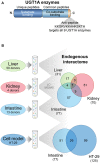Endogenous Protein Interactome of Human UDP-Glucuronosyltransferases Exposed by Untargeted Proteomics
- PMID: 28217095
- PMCID: PMC5290407
- DOI: 10.3389/fphar.2017.00023
Endogenous Protein Interactome of Human UDP-Glucuronosyltransferases Exposed by Untargeted Proteomics
Abstract
The conjugative metabolism mediated by UDP-glucuronosyltransferase enzymes (UGTs) significantly influences the bioavailability and biological responses of endogenous molecule substrates and xenobiotics including drugs. UGTs participate in the regulation of cellular homeostasis by limiting stress induced by toxic molecules, and by controlling hormonal signaling networks. Glucuronidation is highly regulated at genomic, transcriptional, post-transcriptional and post-translational levels. However, the UGT protein interaction network, which is likely to influence glucuronidation, has received little attention. We investigated the endogenous protein interactome of human UGT1A enzymes in main drug metabolizing non-malignant tissues where UGT expression is most prevalent, using an unbiased proteomics approach. Mass spectrometry analysis of affinity-purified UGT1A enzymes and associated protein complexes in liver, kidney and intestine tissues revealed an intricate interactome linking UGT1A enzymes to multiple metabolic pathways. Several proteins of pharmacological importance such as transferases (including UGT2 enzymes), transporters and dehydrogenases were identified, upholding a potential coordinated cellular response to small lipophilic molecules and drugs. Furthermore, a significant cluster of functionally related enzymes involved in fatty acid β-oxidation, as well as in the glycolysis and glycogenolysis pathways were enriched in UGT1A enzymes complexes. Several partnerships were confirmed by co-immunoprecipitations and co-localization by confocal microscopy. An enhanced accumulation of lipid droplets in a kidney cell model overexpressing the UGT1A9 enzyme supported the presence of a functional interplay. Our work provides unprecedented evidence for a functional interaction between glucuronidation and bioenergetic metabolism.
Keywords: UGT; affinity purification; human tissues; mass spectrometry; metabolism; protein-protein interaction; proteomics.
Figures





Similar articles
-
Drug-Metabolizing Activity, Protein and Gene Expression of UDP-Glucuronosyltransferases Are Significantly Altered in Hepatocellular Carcinoma Patients.PLoS One. 2015 May 26;10(5):e0127524. doi: 10.1371/journal.pone.0127524. eCollection 2015. PLoS One. 2015. PMID: 26010150 Free PMC article.
-
Transcriptional regulation of human UDP-glucuronosyltransferase genes.Drug Metab Rev. 2014 Nov;46(4):421-58. doi: 10.3109/03602532.2014.973037. Epub 2014 Oct 22. Drug Metab Rev. 2014. PMID: 25336387 Review.
-
Regulation and function of family 1 and family 2 UDP-glucuronosyltransferase genes (UGT1A, UGT2B) in human oesophagus.Biochem J. 1999 Mar 1;338 ( Pt 2)(Pt 2):489-98. Biochem J. 1999. PMID: 10024527 Free PMC article.
-
Molecular characterization of functional UDP-glucuronosyltransferases 1A and 2B in common marmosets.Biochem Pharmacol. 2020 Feb;172:113748. doi: 10.1016/j.bcp.2019.113748. Epub 2019 Dec 10. Biochem Pharmacol. 2020. PMID: 31830470
-
UDP-glucuronosyltransferases and clinical drug-drug interactions.Pharmacol Ther. 2005 Apr;106(1):97-132. doi: 10.1016/j.pharmthera.2004.10.013. Epub 2005 Jan 12. Pharmacol Ther. 2005. PMID: 15781124 Review.
Cited by
-
Mutual Influence of Human Cytochrome P450 Enzymes and UDP-Glucuronosyltransferases on Their Respective Activities in Recombinant Fission Yeast.Biomedicines. 2023 Jan 19;11(2):281. doi: 10.3390/biomedicines11020281. Biomedicines. 2023. PMID: 36830817 Free PMC article.
-
UDP-Glucuronosyltransferase (UGT)-mediated attenuations of cytochrome P450 3A4 activity: UGT isoform-dependent mechanism of suppression.Br J Pharmacol. 2020 Mar;177(5):1077-1089. doi: 10.1111/bph.14900. Epub 2020 Jan 23. Br J Pharmacol. 2020. PMID: 31660580 Free PMC article.
-
Liquid Chromatography-Tandem Mass Spectrometry (LC-MS/MS)-Based Proteomics of Drug-Metabolizing Enzymes and Transporters.Molecules. 2020 Jun 11;25(11):2718. doi: 10.3390/molecules25112718. Molecules. 2020. PMID: 32545386 Free PMC article. Review.
-
A Non-Canonical Role for the Glycosyltransferase Enzyme UGT2B17 as a Novel Constituent of the B Cell Receptor Signalosome.Cells. 2023 May 2;12(9):1295. doi: 10.3390/cells12091295. Cells. 2023. PMID: 37174695 Free PMC article.
-
Sexual dimorphism in metabolomic and phenotypic spectra of UGT deficiency: findings from the Canadian Longitudinal Study on Aging.Biol Sex Differ. 2025 Apr 22;16(1):26. doi: 10.1186/s13293-025-00708-5. Biol Sex Differ. 2025. PMID: 40264209 Free PMC article.
References
LinkOut - more resources
Full Text Sources
Other Literature Sources

